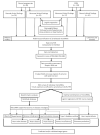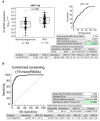Substantially Altered Expression Profile of Diabetes/Cardiovascular/Cerebrovascular Disease Associated microRNAs in Children Descending from Pregnancy Complicated by Gestational Diabetes Mellitus-One of Several Possible Reasons for an Increased Cardiovascular Risk
- PMID: 32604801
- PMCID: PMC7349356
- DOI: 10.3390/cells9061557
Substantially Altered Expression Profile of Diabetes/Cardiovascular/Cerebrovascular Disease Associated microRNAs in Children Descending from Pregnancy Complicated by Gestational Diabetes Mellitus-One of Several Possible Reasons for an Increased Cardiovascular Risk
Abstract
Gestational diabetes mellitus (GDM), one of the major pregnancy-related complications, characterized as a transitory form of diabetes induced by insulin resistance accompanied by a low/absent pancreatic beta-cell compensatory adaptation to the increased insulin demand, causes the acute, long-term, and transgenerational health complications. The aim of the study was to assess if alterations in gene expression of microRNAs associated with diabetes/cardiovascular/cerebrovascular diseases are present in whole peripheral blood of children aged 3-11 years descending from GDM complicated pregnancies. A substantially altered microRNA expression profile was found in children descending from GDM complicated pregnancies. Almost all microRNAs with the exception of miR-92a-3p, miR-155-5p, and miR-210-3p were upregulated. The microRNA expression profile also differed between children after normal and GDM complicated pregnancies in relation to the presence of overweight/obesity, prehypertension/hypertension, and/or valve problems and heart defects. Always, screening based on the combination of microRNAs was superior over using individual microRNAs, since at 10.0% false positive rate it was able to identify a large proportion of children with an aberrant microRNA expression profile (88.14% regardless of clinical findings, 75.41% with normal clinical findings, and 96.49% with abnormal clinical findings). In addition, the higher incidence of valve problems and heart defects was found in children with a prior exposure to GDM. The extensive file of predicted targets of all microRNAs aberrantly expressed in children descending from GDM complicated pregnancies indicates that a large group of these genes is involved in ontologies of diabetes/cardiovascular/cerebrovascular diseases. In general, children with a prior exposure to GDM are at higher risk of later development of diabetes mellitus and cardiovascular/cerebrovascular diseases, and would benefit from dispensarisation as well as implementation of primary prevention strategies.
Keywords: BMI; bioinformatics; cardiovascular risk; children; echocardiography; gestational diabetes mellitus; miRWalk2.0 database; microRNA expression; prehypertension/hypertension; screening.
Conflict of interest statement
The authors declare no conflict of interest.
Figures




Similar articles
-
Association Analysis in Children Born from Normal and Complicated Pregnancies-Cardiovascular Disease Associated microRNAs and the Incidence of Prehypertension/Hypertension, Overweight/Obesity, Valve Problems and Heart Defects.Int J Mol Sci. 2020 Nov 9;21(21):8413. doi: 10.3390/ijms21218413. Int J Mol Sci. 2020. PMID: 33182505 Free PMC article.
-
Diabetes Mellitus and Cardiovascular Risk Assessment in Mothers with a History of Gestational Diabetes Mellitus Based on Postpartal Expression Profile of MicroRNAs Associated with Diabetes Mellitus and Cardiovascular and Cerebrovascular Diseases.Int J Mol Sci. 2020 Mar 31;21(7):2437. doi: 10.3390/ijms21072437. Int J Mol Sci. 2020. PMID: 32244558 Free PMC article.
-
Postnatal Expression Profile of microRNAs Associated with Cardiovascular and Cerebrovascular Diseases in Children at the Age of 3 to 11 Years in Relation to Previous Occurrence of Pregnancy-Related Complications.Int J Mol Sci. 2019 Feb 2;20(3):654. doi: 10.3390/ijms20030654. Int J Mol Sci. 2019. PMID: 30717412 Free PMC article.
-
Circulating microRNAs associated with gestational diabetes mellitus: useful biomarkers?J Endocrinol. 2022 Dec 13;256(1):e220170. doi: 10.1530/JOE-22-0170. Print 2023 Jan 1. J Endocrinol. 2022. PMID: 36346274 Review.
-
Gestational diabetes mellitus and subsequent development of overt diabetes mellitus.Dan Med Bull. 1998 Nov;45(5):495-509. Dan Med Bull. 1998. PMID: 9850811 Review.
Cited by
-
The Hidden Impact of Gestational Diabetes: Unveiling Offspring Complications and Long-Term Effects.Life (Basel). 2025 Mar 11;15(3):440. doi: 10.3390/life15030440. Life (Basel). 2025. PMID: 40141785 Free PMC article. Review.
-
Circulating microRNA-194 levels in Chinese patients with diabetic kidney disease: a case-control study.Ther Adv Endocrinol Metab. 2021 Oct 15;12:20420188211049615. doi: 10.1177/20420188211049615. eCollection 2021. Ther Adv Endocrinol Metab. 2021. PMID: 34676065 Free PMC article.
-
microRNA Bioinformatics.Cells. 2022 Nov 18;11(22):3677. doi: 10.3390/cells11223677. Cells. 2022. PMID: 36429104 Free PMC article.
-
Understanding the Role of GLUT2 in Dysglycemia Associated with Fanconi-Bickel Syndrome.Biomedicines. 2022 Aug 29;10(9):2114. doi: 10.3390/biomedicines10092114. Biomedicines. 2022. PMID: 36140215 Free PMC article.
-
First-Trimester Screening for Fetal Growth Restriction and Small-for-Gestational-Age Pregnancies without Preeclampsia Using Cardiovascular Disease-Associated MicroRNA Biomarkers.Biomedicines. 2022 Mar 19;10(3):718. doi: 10.3390/biomedicines10030718. Biomedicines. 2022. PMID: 35327520 Free PMC article.
References
-
- International Diabetes Federation IDF Diabetes Atlas–Across the Globe. [(accessed on 12 April 2020)];2017 Available online: http://diabetesatlas.org/across-the-globe.html.
-
- Bowes S.B., Hennessy T.R., Umpleby A.M., Benn J.J., Jackson N.C., Boroujerdi M.A., Sönksen P.H., Lowy C. Measurement of glucose metabolism and insulin secretion during normal pregnancy and pregnancy complicated by gestational diabetes. Diabetologia. 1996;39:976–983. doi: 10.1007/BF00403918. - DOI - PubMed
Publication types
MeSH terms
Substances
LinkOut - more resources
Full Text Sources
Medical

